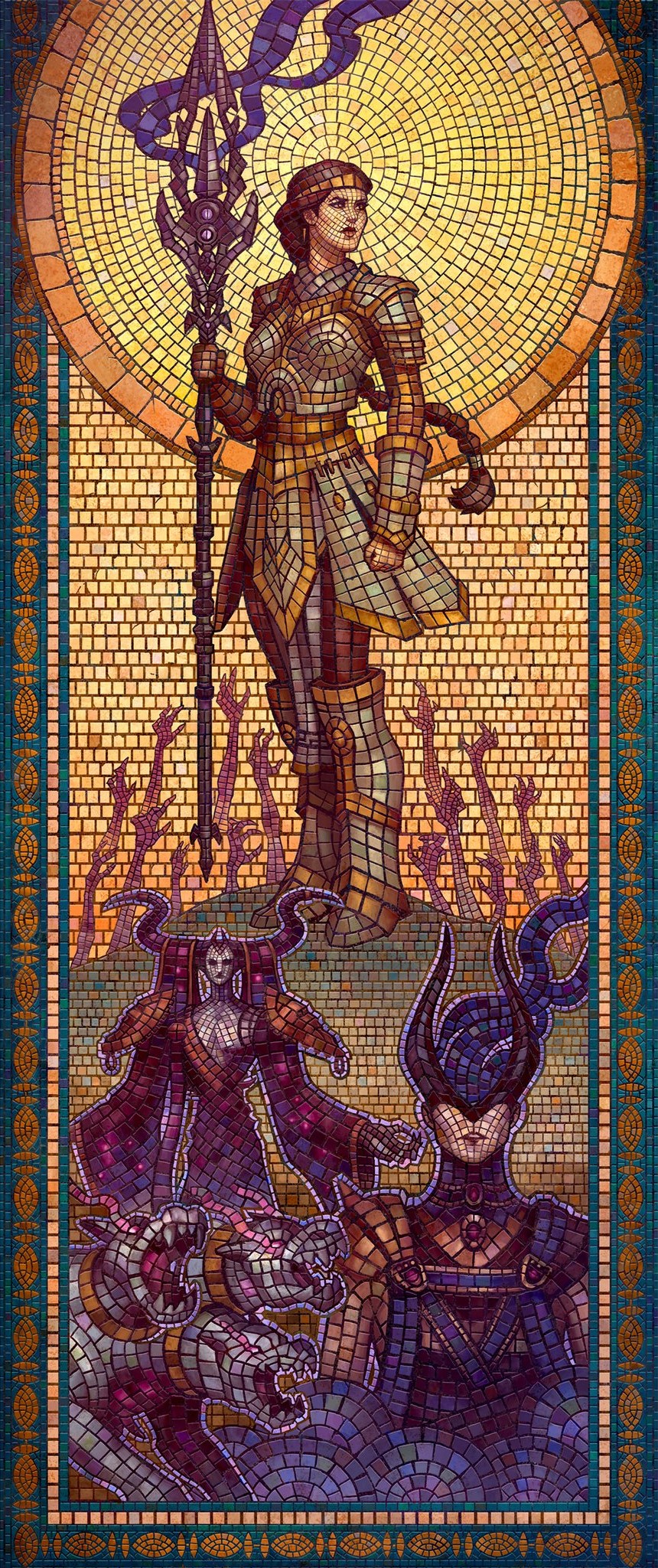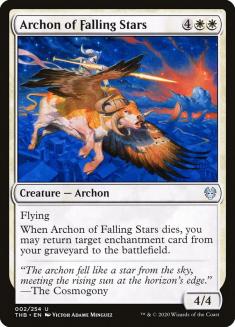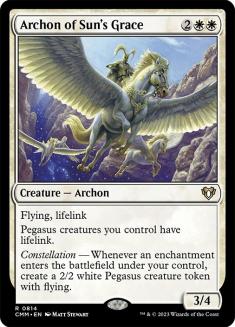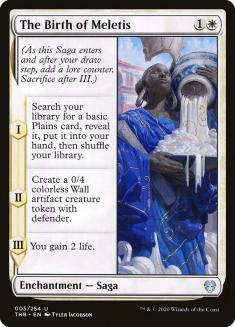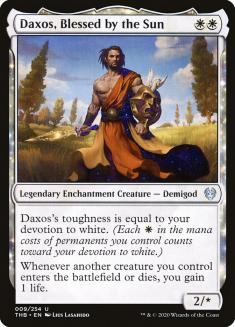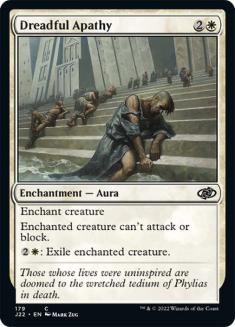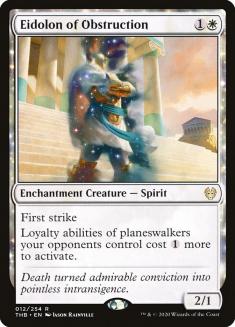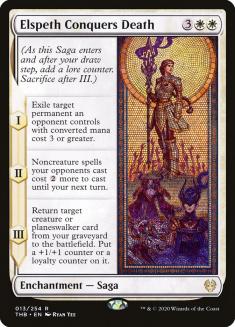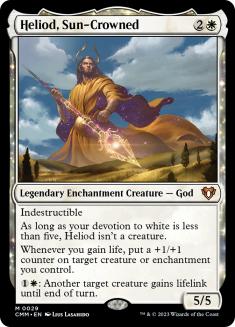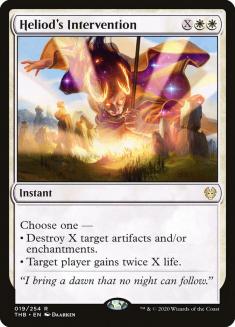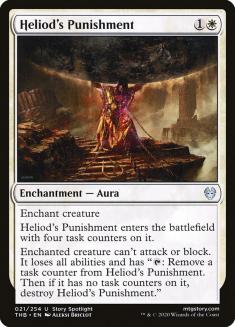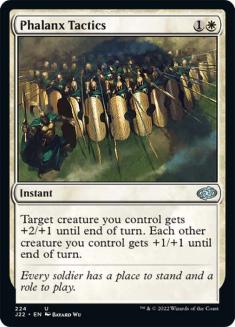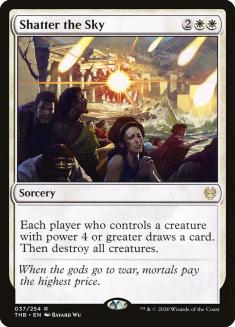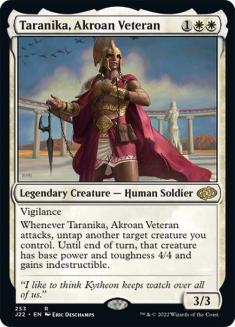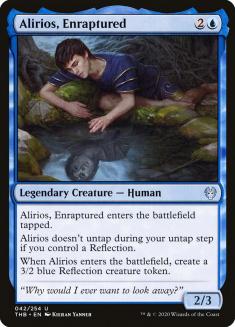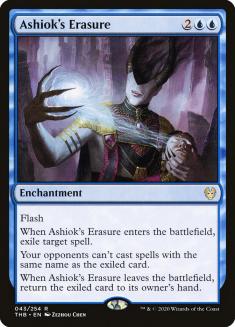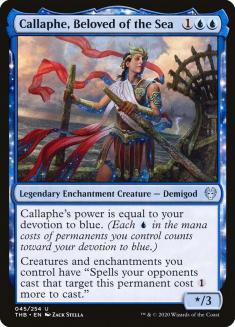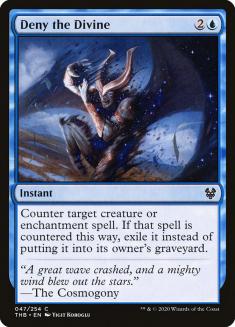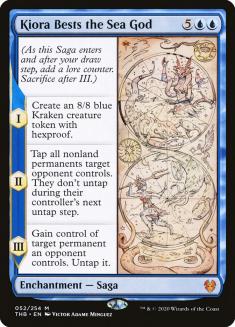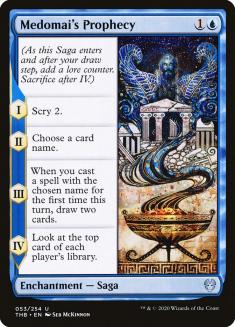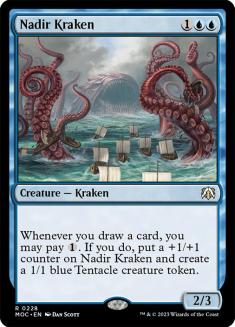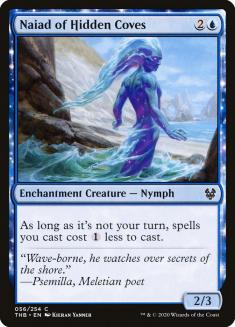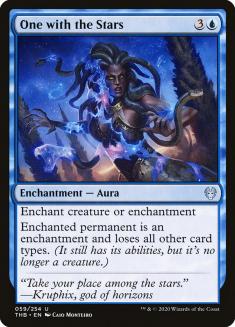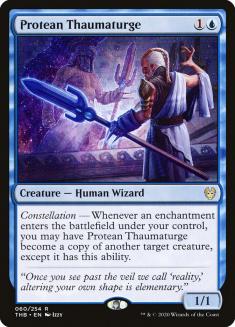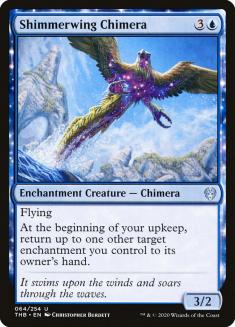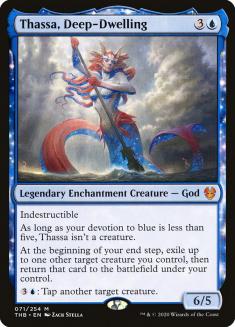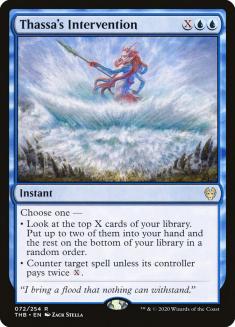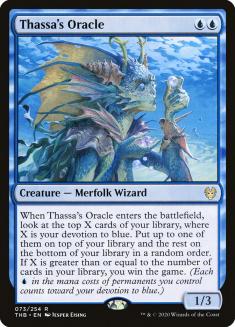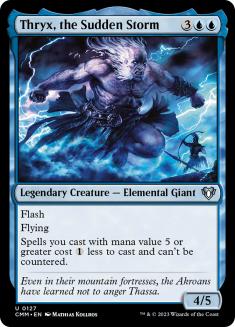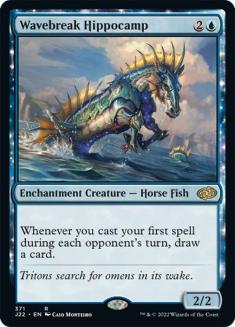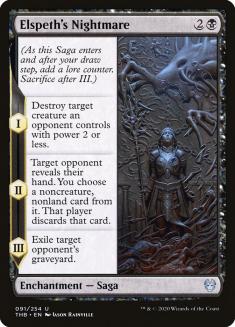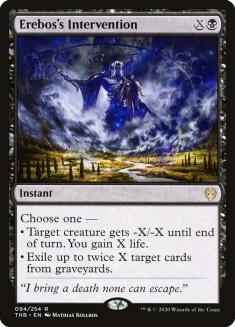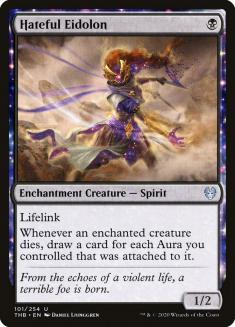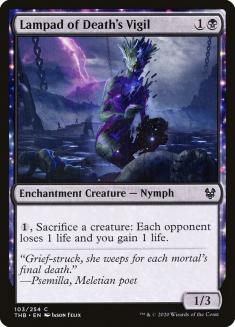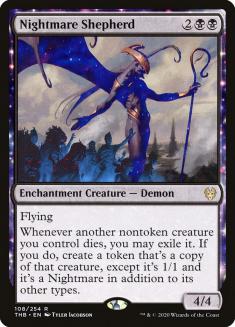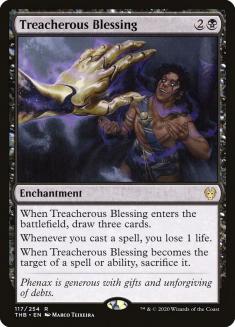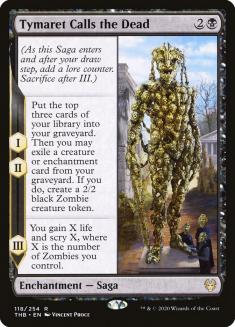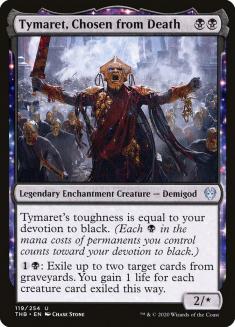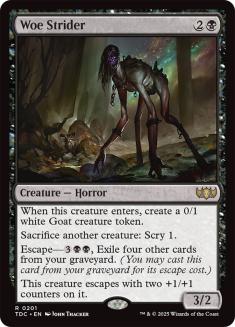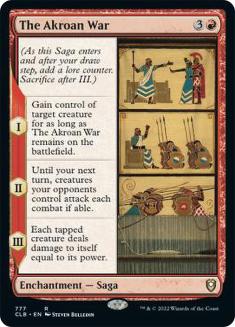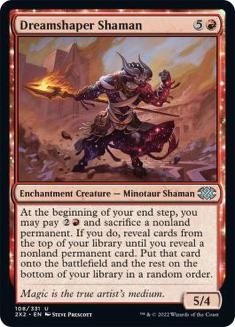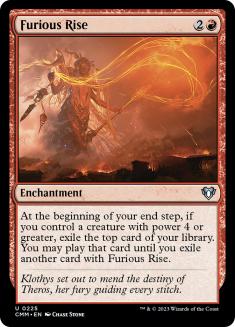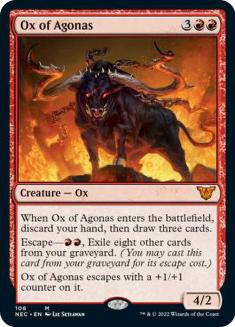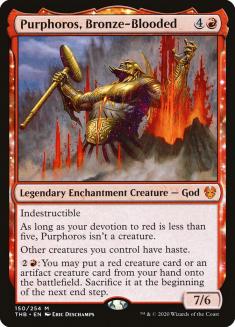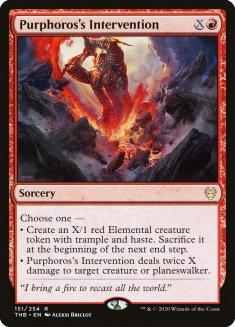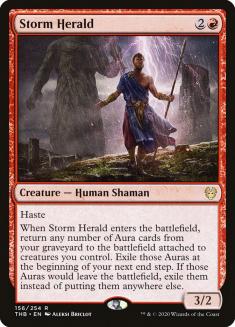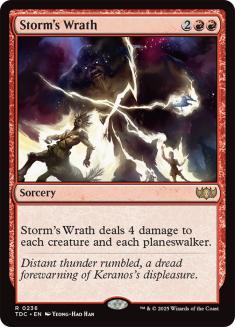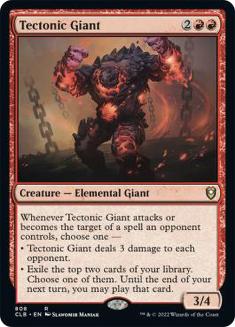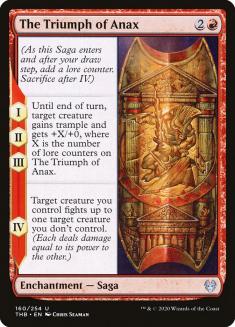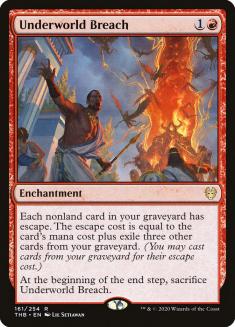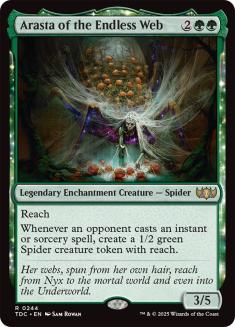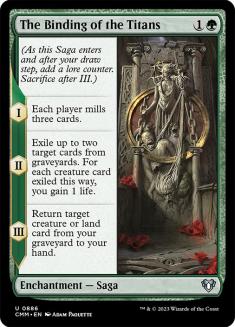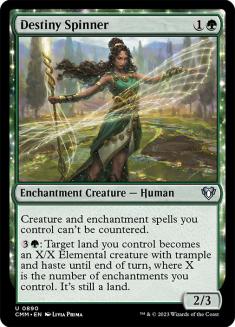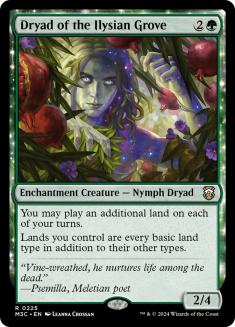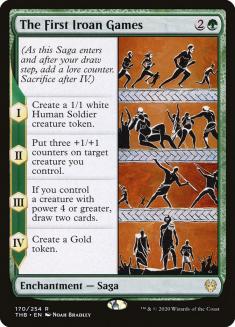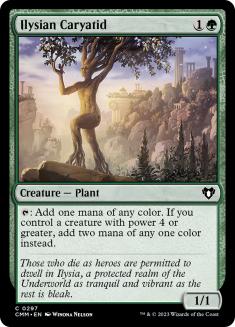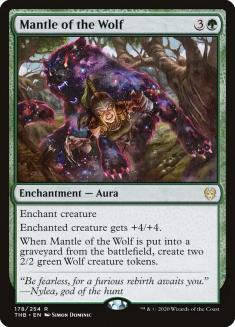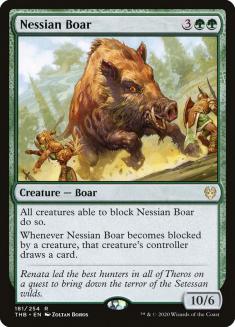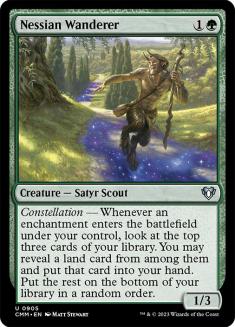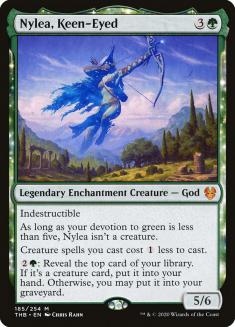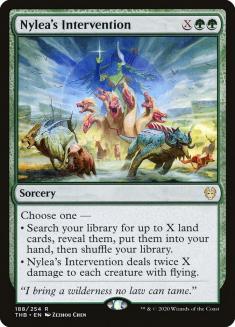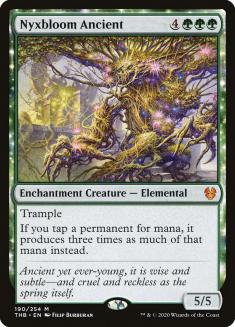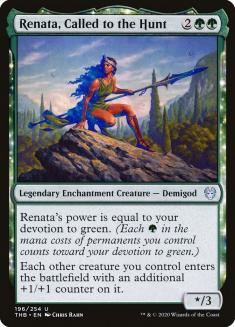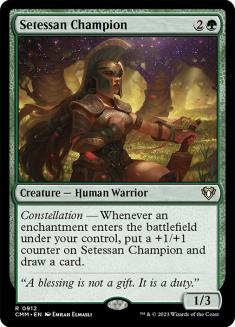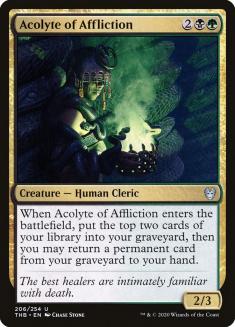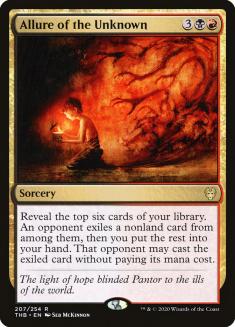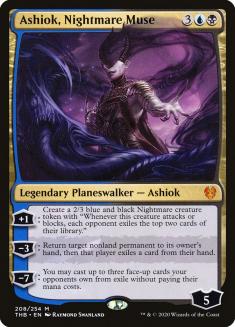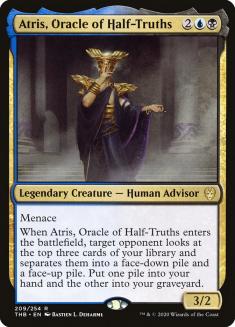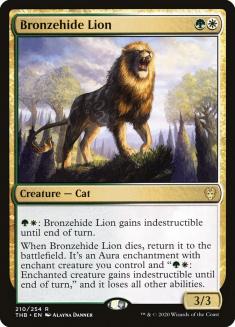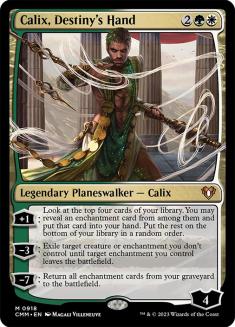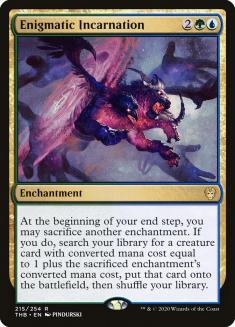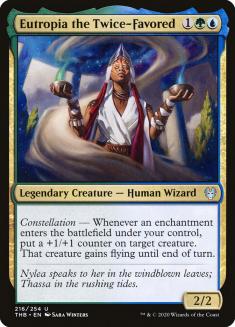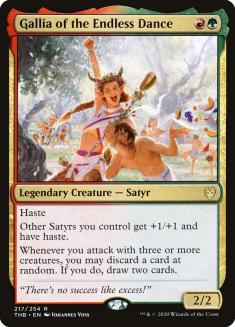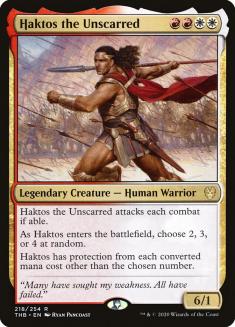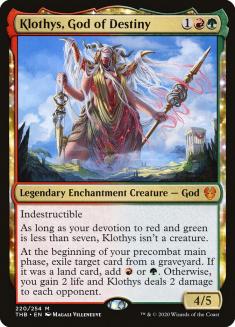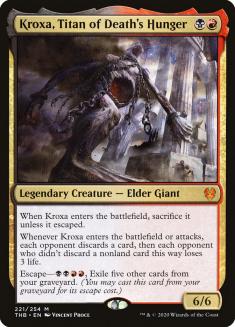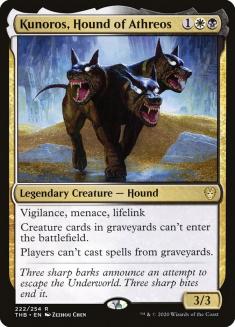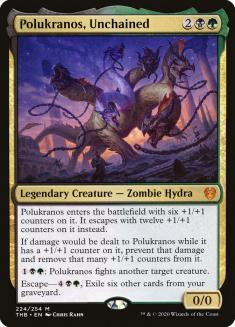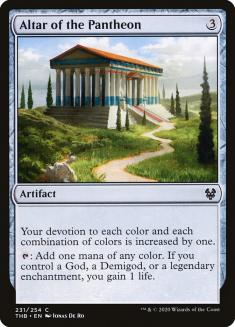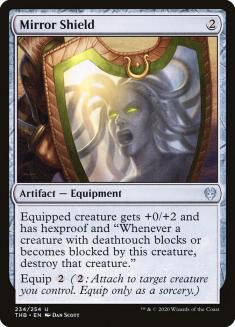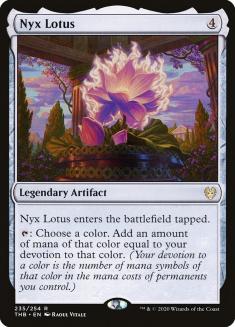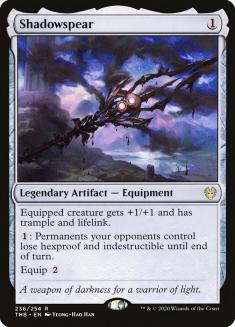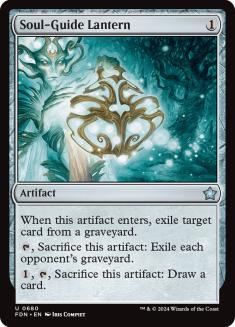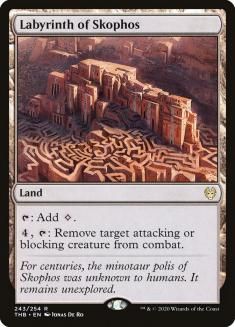Delving into the underworld of a popular plane we’ve explored before, Theros Beyond Death is about to fill your Commander decks with dreamy spells and powerful creatures. It’s an amazing follow-up to Throne of Eldraine¸ already one of the most popular sets ever for the format.
As always, remember that this is a Commander-only review. Cards that will be houses in Limited or other Constructed formats might not make the cut in the 100-card decks. I’ll mention the cards that I’m pretty sure will see regular play, highlight some outside-the-box choices, point out the occasional gaffe, and then grade each color and pick a Top 3. As you’ll see, only one of them didn’t get a strong grade, making it overall an A+ set.
White
You’re going to play strong enchantments, and other people are going to want to justifiably blow them up. Archon of Falling Stars is a little protection. Also, now if someone sweeps your battlefield with Planar Cleansing, at least you can get your best enchantment back.
I’m not sure this is going to see loads of play, but in a format where Storm Herd is a thing, Archon of Sun’s Grace will be glorious.
I love that Sagas are back, but this extremely well-named one leaves me cold. I get that it’s uncommon and costs only 1W so it can’t be too powerful, but Act III is just a real letdown.
While a small-creature-army build might seem obvious, I’m thinking more along the lines of putting this version of Daxos into your Doran, the Siege Tower decks, where it will be able to do big damage.
A quite compelling card for a common. When you use the activated ability to exile the creature, the enchantment will fall off—and you’ll be running some recursion for enchantments, so it’ll be all good in the end.
No free lunch, SuperFriends! Unfortunately, most planeswalker-heavy decks you’ll see also pack lots of creature hate, so you’ll have to pick your spots.
Now we’re talking! Elspeth Conquers Death is an perfect example of how a Saga can craft a story and be just a really good card. Act I is pretty straightforward (and remember, if anyone asks, you don’t target until after the spell has resolved, so don’t let anyone force you to commit to anything you’re not ready to do). It’s always going to find a target in Commander. Act II means two things. First, your stuff will be more difficult to counter. Second, it’ll be harder for an opponent to combo off, at least with noncreature spells. Act III literally conquers death. Add insanely good art, and you have one of the best cards in the set. It’s another one that will challenge my resolve in only putting a single copy of new cards into my deck suite.
When I first saw the card, I instinct was that five loyalty for four mana was dangerous. Upon further reading and seeing no ultimate, those fears were alleviated. The card is functional, but I was hoping for something splashier out of such a central character.
One of my early favorites, and seeing the rest of the set hasn’t dampened my enthusiasm for Heliod. Lifelink is an under-appreciated ability in Commander. Also, I love that Heliod’s triggered ability can put a +1/+1 counter on itself even when it’s not a creature. You know that it eventually will be, and some stronger beats are always advised.
When you need to take out some artifacts and enchantments but don’t want to wipe out your own, there’s Heliod’s Intervention. It’s not going to work for a battlefield choked with them, but you’re always going to have some juicy targets. I don’t see myself using the lifegain in a non-emergency situation too often, but it certainly had me searching for other “whenever you gain life” cards to make sure I wasn’t missing something.
I’m not sure if Heliod’s Punishment is good, but in a world with proliferate in it, the card becomes a good think piece.
The downside to the card is that it can be countered by someone removing the target. The upside is that if you’re going wide, you target something that’s less important and make them spend a removal spell—and targeted removal is really at a premium in Commander—on something they might not otherwise want to.
A compelling take on a sweeper, Shatter the Sky lets you replace itself when you have to punch out because someone else’s battlefield is better than yours. It’s also a nod to not letting creatureless control off the hook. I’m not the biggest fan of helping opponents draw cards, but this is an exception I’m willing to make.
I was pretty meh on Taranika until I got to the indestructible part. Phantom Nishoba will be a favorite target. Even if it makes a creature smaller, there might be value in using the ability, such as if you know you’re going to have to use a sweeper of your own post-combat.
Stuff being less expensive to cast? Nothing could go wrong, right?
Top 3:
Grade: C. Very strong Top 3, but the density fades pretty quickly.
Blue
Thematically a card that feels like it could have been in Throne of Eldraine, Alirios gains value in your deck with blink shenanigans going on. Who cares if it doesn’t untap? There are plenty of ways of getting around the restriction as well, like turning all your creatures into some other creature type with Arcane Adaptation.
Speaking of blink shenanigans, messing up someone’s spell timing seems pretty chaotic. My favorite use here will be exiling a copy of a spell.
More messing with the math, Callaphe is also just going to be large and in charge in any number of blue decks. It’s going right into my Thassa, God of the Sea Merfolk deck.
I’m not usually on board in Commander with one-for-ones, but counterspells that exile the spells unconditionally get my attention. So do playable commons.
Another Saga telling a great story (really, the lover of narrative in me is getting pretty fanboy-ish over these things), Kiora Bests the Sea God does all the things. Acts I and III are great in their own rights, but Act II is going to end up with the largest in-game impact, as it locks down an opponent for two combat steps—certainly enough to deal with someone that’s become problematic. Once you’ve killed them, you can steal a permanent from one of the players left in the game.
I suspect the complaint will be that it doesn’t really do anything until Act III, but given the very low mana investment, I’m on board. I’ll be interested to see any kind of bluffs that Act II will provide.
It’s no Chasm Skulker, but not everything has to be busted to be good. Getting even more mileage out of your Rhystic Study or Mystic Remora is gold.
“Playable common” doesn’t even begin to touch Naiad of Hidden Coves. Control/counterspell decks are going to love it as well as anyone who casts instants that are X spells.
The flexibility alone is worth playing the card and justifies its eminently splashable cost. There are some unusual lines in which you might have enchantment removal but no other kind, which might further encourage you to play One with the Stars. Enchantress decks (well, the ones with blue in them) are certainly jamming it.
The hits keep coming for blue. I’m a fan of playing stuff like Riptide Mangler, Shapesharer, and friends, so Protean Thaumaturge seems like getting loads of value out of two mana.
You may sign me up for bouncy enchantments with great enters-the-battlefield triggers, to include a bunch of them from this very set.
Conjurer’s Closet on an indestructible stick is just fine by me. As if that weren’t quite good enough, there are going to be plenty of times when that tap ability is going to get you out of a tight spot.
The Gods’ Interventions are strong, as they should be. Giving you the flexibility of having card draw ora counterspell (and frequently, X for one is going to be enough) is quite strong.
Okay, deep breath. Yes, someone on the RC saw this card before it was previewed. Yes, we’re aware of the implications in cEDH. For the format’s core demographic, this is a very cool and not particularly dangerous card. Will some folks be tempted to run the instant-win package? Sure. Will enough do so to warp the format around it? Not anywhere close. There’s nothing about this card that suggests taking any kind of immediate or aggressive action on.
Another of my early favorites. If anything, the more cards we see from the set, the more excited I am about Thryx. Casting stuff that costs five or more is the life’s blood of Commander. In a late-game situation, we might see Thryx flashed in to prevent countering some other important and expensive spell. Most of the time, I suspect we’ll see the normal play line of flashing it in at the end of turn of the player on your right so as to protect it from sweepers and whatnot, and then just going to town.
Someone in Play Design really wants counterspell decks to make a comeback. I suppose CAG member Josh Lee Kwai will write this one into his decklists right alongside Vedalken Orrery. You don’t need to be playing any kind of control to take advantage of the Hippocamp, either. All you need are some instants here and there, and you’ll be profiting. Really solid card at a sweet mana cost.
Top 3:
Grade: A. Great top cards and flavor that keeps on going.
Black
Merely okay until you get to the end of the story. Acts I and II aren’t likely cards you’d play on their own. Getting them along with the graveyard exile of Act III is worth the relatively low 2B mana cost.
It seems like Erebos, Bleak-Hearted it almost playable without the triggered ability. Adding it in pushes the card right over the top into the bonkers category. My final comment is that Repay in Kind is a thing.
As I said last week, the fact that you can exile 2X cards from multiple graveyards without having to hit your own nerfs some graveyard strategies pretty well without hurting your own in the least. I suspect that will be the major use of the card in the format, with the creature removal the emergency case.
Quick poll: who was more excited about Gravebreaker Lamia — Karador, Ghost Chieftain or Muldrotha, the Gravetide? Trick question, because it’s me! My hardest decision will be which of the two to put it into. If the cost reduction wasn’t enough to get your motor running, the fact that it also is an Entomb should get you humming quite nicely. Then we add in lifelink and it’ll see plenty of play.
One of the issues throughout the game’s history is that Auras were bad because you could easily get two-for-one’d by removal spells. Hateful Eidolon helps mitigate some of that problem.
One of my constant issues with some (not all, but some) of the black “sacrifice a creature” cards is the colored mana involved. Happy that we have one here that costs only one and has a nice ability. I’m not concerned with the ability itself being that great, it’s mostly about the ability to sacrifice creatures to either reanimate them from the graveyard or to keep others’ filthy mitts off them.
I mention it only because there aren’t yet enough cards that bring things back from exile to warrant me playing the card. I love my graveyard, and I’d like to keep it there (or on the battlefield, thanks).
The life loss is insignificant compared to the card draw, and you know that if you’re putting Treacherous Blessing into your deck, you’ll either have ways to bounce it or to target it. I find the design quite compelling.
As mentioned, I don’t like exiling stuff from my graveyard, but you don’t really need to in order to get value out of the card. You’ll be playing it in a Zombie deck anyway, so you’ll get the self-mill you want in order to make that Patriarch’s Bidding or Tombstone Stairwell so much saucier.
This will clearly be a high-impact card in the format. Since you have the choice of exiling any cards and they don’t have to come from the same graveyard, you have lots of flexibility. The lifegain is nice but not important. I’ll certainly be using this Tymaret to make sure that your graveyard isn’t all that good while still setting up mine for lots of cool things.
Move over Viscera Seer, there’s a Goat-maker in town. You can’t do the tomfoolery of sacrificing it to itself, but that’s small price to pay for the zero-mana-cost creature sacrifice that I so love and need. Plus, Goats!
Top 3:
Grade: A-. Quality and decent density. Almost a full A because more than three could be in the top.
Red
Another Saga, another cool story (that no one is even saying “bro” after). Note that unlike Threaten, Act I doesn’t give the creature haste.
Anax solves one of the problems of small, swarming creature decks (at least those that don’t rely on tokens) by replacing the stuff that gets killed. There are plenty of mono-red and Boros decks that would benefit from the extra creature boost as either a recovery method or a finishing move with a sacrifice outlet like Goblin Bombardment.
One thing you could do with those tokens is sacrifice them to Dreamshaper Shaman in order to get bigger, better things. This is my kind of card.
I’m a fan of the cool take on the red mechanic that we called “bottling” in R&D (after Elkin Bottle). It slots into Naya or Gruul big creature decks at a nice mana cost, even if folks get to see it. Sometimes, that’s a nice rattlesnake.
More likely to make a splash in other formats, but there’s probably still room in Commander for the Ox in decks that empty their hands quickly. At first I thought the escape cost might be a little too much, but drawing three cards and getting a 5/3 for RR is pretty damn good.
Said it before, and you’ll hear me say it again: haste kills people. The not-broken Sneak Attack makes this Purphoros strong without fueling the same kind of insanity. It’s a card you can’t just jam into decks; you’ll have to build around it. When you do, it’ll be saucy.
And the streak of really good Interventions is done. Neither mode is particularly good in Commander; the second one would need to be able to target a player as well.
I was on board until the exile clause. That said, there’s some kind of finishing move here, like with an Empyrial Armor that’s already done some work.
I was looking for a red creature damage spell that wasn’t all-in like Blasphemous Act or Chain Reaction, so Storm’s Wrath fit the bill. The damage to planeswalkers is a nice bonus.
Tectonic is an extremely sweet card. Putting Basilisk Collar on it would be sweet, too. The radically different modes you get to choose from let you adjust to game circumstances. There are times you’ll be able to attack one player and kill another with the trigger, which is just fine by me.
The six extra damage over three turns is less significant than trample, which is even more of a killer than haste. Act IV goes a different direction and can be awkward, considering it’s not optional.
There are certainly combo possibilities with Underworld Breach, which includes its own self-limitation.
Top 3:
Grade: D. Struggled to find a Top 3, density is low. The color will be good for other formats, though.
Green
Friend of the show and Ishkanah, Grafwidow player Brian David-Marshall will alternately love Arasta because of the Spiders it creates and hate it as “too easy.” Brian is a Spider Spawning kind of guy, not Arachnogenesis.
Another Saga nicely priced for what it does, Binding of the Titans fits what you want to do, whether that’s dredge or just putting stuff into your graveyard for other purposes. Act II will get rid of the nastiest things in graveyards. Act III is useful in case you’re not playing reanimation or you milled the land you really wanted or needed.
Since I’m a pretty big fan of creature and enchantment spells, Destiny Spinner is for me. Enchantment creatures, like Destiny Spinner, are great creative space because a designer can put a slightly more powerful effect into a slightly cheaper cost due to the inherent vulnerability that also being an enchantment brings with it. I wouldn’t want to go there all the time, but every now and again is money.
One of the most anticipated cards of the set, and what I just said about enchantment creatures definitely applies. One of the two abilities on the card would make it playable at the cost. Both make it an immediately popular card in the format. Get your foils early, because they’re going fast.
We keep telling great stories with these Sagas. I’d like to play this one with Hex Parasite so that I could keep reading Act III over and over again. Some folks have pointed out the card is a flavor fail because of the text on Arena Athlete, but remember, these were the first Iroan Games. Arena Athlete was obviously in subsequent versions.
A mana creature that scales once you have bigger creatures (and four power isn’t all that big) to cast bigger creatures can probably get out of hand, especially if you have something to untap it.
Earlier I said that one of the issues with Auras is getting blown out if the creature gets destroyed. Enter Mantle of the Wolf, which basically replaces itself in power. The 3G cost might still be one higher than would get it played regularly, but I’m willing to give it a shot, especially in a deck that has Greater Good. Sacrificing the enchanted creature to Greater then nets you four extra cards plus the two tokens. Good all around.
I’m not yet sold on Nessian Boar in Commander (though it could get me back into Standard), but I’ll confess I wasn’t sold on Grothama, All-Devouring. The Lure effect on a huge creature is something relatively new, and I’m at least curious to see how it’ll play out. Of course, a ten-power five-mana creature on an otherwise empty battlefield wrecks people pretty quickly.
At no cost to you once it’s on the battlefield, Nessian Wanderer gains you effective card draw for doing what you’re doing anyway—casting those enchantments. In Enchantress decks, it’s going to thin you of lands so that you’re just drawing gas. An unspectacular but solid piece of a popular deck archetype.
Flabbergastingly good, new Nylea gets my vote for one of the best cards of the set. Making creatures cheaper will lead places. Getting more of them with the activated ability (there’s that effective card draw again) means you get the cream of the crop to choose from.
Just hold on. Everyone re-read the first mode. It doesn’t say basic land cards, it just says land cards. Any land cards. If you have combos of lands, like Urborg, Tomb of Yawgmoth and Cabal Coffers, or Dark Depths and Thespian’s Stage, here you go. As Theros Beyond Death focuses on devotion, I imagine Nykthos, Shrine of Nyx might also be a popular choice.
Another one that’s been the topic of much discussion since it was previewed, Nyxbloom Ancient is going to both create and fuel insanity. While it might not centralize games the way a card like Primeval Titan did, folks will want to copy and steal it. If you tap out to cast it, be emotionally prepared for the fact that you might not be the only player with one of them by the time your turn comes back around. And get out your calculator if you’re copying it yourself.
To say green is the winner for Theros Beyond Death is to undersell what winning is. Renata will get large. She will also make your team much larger. There’s the obvious combo with persist creatures, like Woodfall Primus, since the +1/+1 counter will wipe out the -1/-1. Awesome card that won’t make the Top 3.
All around the world, I hear rebuilds of Enchantress decks happening as we speak.
Top 3:
Grade: A+. Just over the top in terms of quality and number of playable cards, some of which there wasn’t even room to mention.
Multicolored
Not quite as good as Eternal Witness, since it only returns permanents, but still a fine part of your recursion package, especially since it gives you two more cards to choose from. Note that Acolyte of Affliction doesn’t target the card you return, meaning that you don’t have to choose it until the ability resolves. It’ll get around Ground Seal and make people spend graveyard hate on your best choices without completely blowing you out.
I’m not a fan of complete chaos, but cards like this pique my interest. Drawing five cards for five mana is pretty good, even if an opponent—and you can certainly choose wisely among the other people at the table—gets something too. I’m most likely to play Allure of the Unknown in a Jund deck so that I can also play Brooding Saurian and just get back whatever they cast.
There are so many cool things happening with this card. In the end, the ultimate is what matters, since you’re playing a bunch of other cards that exile your opponents’ cards, like Ashiok, Dream Render and Ashiok, Nightmare Muse, plus Relic of Progenitus and friends.
Count me as a fan of this kind of gamesmanship on cards. Sometimes, the opponent will even give you a favorable and obvious split in order for you to deal with a looming threat.
First of all, it’s a 3/3 for two mana. Then, it has two amazing abilities. Too bad you can’t use the Aura version to enchant other players’ creatures.
In any other set, we’d be raving over Calix. In this one, people are saying “Sure, it’s really good, but have you seen <any number of cards>?”
We’re all looking at building the enchantment creature deck so that we can take advantage of Enigmatic Incarnation (or Enchantment Pod as I’ve already heard it called). My first thought was to use it with the Omens or Cartouches from Amonkhet, enchantments which have good enters-the-battlefield triggers but might not do much once they’re on the battlefield. I’m sure there are uses for Enigmatic Incarnation which are more busted than that; I’ll be happy to search for them.
The card wouldn’t likely see play with one of the two abilities. With both, we’ll definitely see it.
Seeing some of the other legendary creatures in the set, I’m less excited about building Gallia than I was last week, but that excitement hasn’t completely drained away.
Haktos will have protection from quite a bit on a Commander table. You’ll have to be careful if you want to build it as a Voltron commander, since you might neuter some of your own Equipment. Still, six power that can’t be blocked by a majority of what’s on the battlefield is just fine by me.
Klothys is definitely a commander to build. You’ll need some other permanents to turn it on, but it’s a 4/5 for just three mana, and it strips annoying stuff from other graveyards. Be careful, though, since the ability is not optional. You’ll be safe in most mid- and late-game situations as other graveyards fill up.
Maybe a little too narrow since recasting it multiple times via the escape cost can get expensive, it could still be fun in a deck with Warstorm Surge and recursion.
Well, then. I have a target for the first creature of yours I kill, I suppose. If you want to build around it, Kunoros seems like an amazing Voltron commander. It already has three great combat abilities, so you can just go with the buffs and triggers, like Sword of Fire and Ice. I don’t actually have a Voltron build, so this might be the one I pick.
In order to confuse and befuddle your friends, play Vigor alongside Polukranos. The answer is that when two replacement effects try to modify the same event, the player who controls the affected permanent chooses which one applies. You’ll obviously choose Vigor and put more counters onto Polukranos instead of taking them off. And you can still fight. In fact, it’s now encouraged. Even without cool combos, we live in a proliferate world, so you can keep this monster alive even longer.
Another much-ballyhooed card (in Simic, like they don’t have enough good stuff), you might never need to hard cast Uro to get extreme value. My question will be how good it can be out of the command zone. What’s the point of diminishing returns when you want to cast it from the command zone, let it stay in the graveyard, and then cast it via the escape cost? I think people will play it just to have an excellent chance of ramping on Turn 3 every time.
Top 3:
Grade: A. Great top cards and lots of good ones considering there’s a smaller number compared to other colors.
Artifact and Land
Playable commons. With neat abilities that are full of flavor win. This set is bonkers.
Maybe the biggest flavor win in the set, Mirror Shield does some heavy lifting due to the fact that it grants hexproof. Now your Animar, Soul of Elements need not fear that lone Acidic Slime barring its path.
Imagine how insane people would be going over the card if it entered the battlefield untapped. It’s obviously less consistent than Gilded Lotus, but its upside potential is so great that it’s a suitable replacement—or simply a great companion.
So inexpensive to cast and equip and with so much upside, Shadowspear turns nearly any creature into the hero we’ve been waiting for. Again, trample kills players. Being able to turn off Avacyn, Angel of Hope for just one mana is huge.
A strict upgrade from Relic of Progenitus, Soul-Guide Lantern goes right into decks that can recur it, like Glissa, the Traitor. Use it a few times to clear out graveyards, a few more to draw some cards. Everyone (and by everyone, I mean you) wins.
A Maze of Ith that produces mana, though you have to pay for the privilege. It seems worth paying for.
Top 3:
Grade: A. Normally, I’d say there were too few cards, but the fact that there’s a valid Top 3 in only eleven cards means something.
Theros Beyond Death will bring a new level of awesomeness to your Commander decks. There’s a little bit of power creep, but it gets reined in relatively well. The set is as good as has been made from a flavor perspective, which makes the strong cards even more worth playing. Ethan Fleischer and the team should be extremely proud of what they’ve put together here.

